Characterization of the Stretch Flangeabitity of High-Strength Bainitic Steel: The Significance of Variant Pairs
Abstract
:1. Introduction
2. Experimental Procedure
3. Results and Discussions
3.1. The Mechanical Properties and the Hole Expansion Ratio
3.2. Morphological Structures
3.3. EBSD Analysis of Grain Size and Angle Grain Boundary Distribution
3.4. Texture Analysis
3.5. Variant Pairing Analysis
4. Conclusions
- (1)
- The contributions of the volume fraction of retained austenite, the M/A (martensite austenite constituents) fraction, the precipitations, the grain diameter of the ambient microstructure, the density of high angle grain boundaries, and the texture to the HER were limited. They were not the controlling factors for the HER.
- (2)
- The HER was closely correlated to the dominating crystallography groups. Whether or not the high-angle-variant pairs were transformed from the same CP group played a critical role in determining the HER, which was ascribed to that the variants within the same CP group sharing a common habit plane. For the high-HER steel, the CP groups dominated the transformation, while it was the CP groups and Bain groups together that determined the transformation for low-HER steel.
- (3)
- The types of variant pairs and their fractions contributed significantly to the HER. High-angle variant pairs of V1/V2, V1/V3, V1/V7, and especially the V1/V2 pair were beneficial to the HER, whereas the impacts of high-angle-variant pairs of V1/V6, V1/V9, V1/V10, V1/V12, V1/V15, V1/V17, and V1/V18 were limited or even detrimental. This result showed that the variant pair type and their fractions might account for most the variation of HER in this steel. The variant pairs deserve further attention, and they provide new insight into the actions in enhancing the HER.
- (4)
- The effects of the variant pairs to HER were attributed to the differential dislocation transmission ability across GBs. The V1/V2 pair was specialized in supplying a slip passage for dislocation transmission across a grain boundary with little resistance, whereas the dislocation transmission ability across the inter-variant boundary of V1/V9, V1/V12, and V1/V15 was particularly poor.
Author Contributions
Funding
Institutional Review Board Statement
Informed Consent Statement
Data Availability Statement
Conflicts of Interest
References
- Xu, L.; Barlat, F.; Lee, M.-G. Hole expansion of twinning-induced plasticity steel. Scr. Mater. 2012, 66, 1012–1017. [Google Scholar] [CrossRef]
- Pathak, N.; Butcher, C.; Worswick, M. Assessment of the critical parameters influencing the edge stretchability of advanced high-strength steel sheet. J. Mater. Eng. And. Perform. 2016, 25, 4919–4932. [Google Scholar] [CrossRef]
- Sadagopan, S.; Urban, D. Formability Characterization of a New Generation of High Strength Steels; Technical Report, No. 0012; Office of Scientific and Technical Information: Oak Ridge, TN, USA, 2003. [Google Scholar]
- Surajit, K.P. A critical review on hole expansion ratio. Materialia 2020, 9, 100566. [Google Scholar]
- Chen, X.; Jiang, H.; Cui, Z.; Lian, C.; Lu, C. Hole expansion characteristics of ultra high strength steels. Procedia Eng. 2014, 81, 718–723. [Google Scholar] [CrossRef] [Green Version]
- Jha, G.; Das, S.; Lodh, A.; Haldar, A. Development of hot rolled steel sheet with 600MPa UTS for automotive wheel application. Mater. Sci. Eng. A 2012, 552, 457–463. [Google Scholar] [CrossRef]
- Choi, S.H.; Kim, E.Y.; Kim, S.I. The micromechanical deformation behaviors of hot-rolled 590FB steel during hole-expansion test. Int. J. Plast. 2014, 58, 184–200. [Google Scholar] [CrossRef]
- Hudgins, A.W.; Matlock, D.K. The effects of property differences in multiphase sheet steels on local formability. Mater. Sci. Eng. A 2016, 654, 169–176. [Google Scholar] [CrossRef]
- Panich, S.; Chongbunwatana, K.; Kamonrattanapisud, M. Formability prediction of advanced high-strength steel sheets by means of combined experimental and numerical approaches. Procedia Manuf. 2019, 29, 528–535. [Google Scholar] [CrossRef]
- Kim, J.H.; Lee, M.G.; Kim, D.; Matlock, D.K.; Wagoner, R.H. Hole-expansion formability of dual-phase steels using representative volume element approach with boundary-smoothing technique. Mater. Sci. Eng. A 2010, 527, 7353–7363. [Google Scholar] [CrossRef]
- Paul, S.K.; Mukherjee, M.; Kundu, S.; Chandra, S. Prediction of hole expansion ratio for automotive grade steels. Comput. Mater. Sci. 2014, 89, 189–197. [Google Scholar] [CrossRef]
- Matsuzu, N.; Itami, A.; Koyama, K. Stretch-Flange Formability of High-Strength Steel; SAE Technical Paper 910513; Society of Automotive Engineers, INC: Warrendale, PA, USA, 1991. [Google Scholar]
- Narayanasamy, R.; Sathiya Narayanan, C.; Padmanabhan Palani Venugopalan, T. Effect of mechanical and fractographic properties on hole expandability of various automobile steels during hole expansion test. Int. J. Adv. Manuf. Technol. 2010, 47, 365–380. [Google Scholar] [CrossRef]
- Kuwabara, T.; Hashimoto, K.; Iizuka, E.; Yoon, J.W. Effect of anisotropic yield functions on the accuracy of hole expansion simulations. J. Mater. Process. Technol. 2011, 211, 475–481. [Google Scholar] [CrossRef]
- Suzuki, T.; Okamura, K.; Capilla, G.; Hamasaki, H.; Yoshida, F. Effect of anisotropy evolution on circular and oval hole expansion behavior of high-strength steel sheets. Int. J. Mech. Sci. 2018, 146–147, 556–570. [Google Scholar] [CrossRef]
- Matsuno, T.; Sato, K.; Okamoto, R.; Mizumura, M.; Suehiro, M. Synergy effect of shear angle and anisotropic material ductility on hole-expansion ratio of high-strength steels. J. Mater. Process. Technol. 2016, 230, 167–176. [Google Scholar] [CrossRef]
- Wang, N.-M.; Wenner, M.L. An analytical and experimental study of stretch flanging. Int. J. Mech. Sci. 1974, 16, 135–143. [Google Scholar] [CrossRef]
- Xu, L.; Chen, L.; De Cooman, B.C.; Steglich, D.; Barlat, F. Hole expansion of advanced high strength steel sheet sample. Int. J. Mater. Form. 2010, 3, 247–250. [Google Scholar] [CrossRef]
- Cohen, T.; Masri, R.; Durban, D. Analysis of circular hole expansion with generalized yield criteria. Int. J. Solids Struct. 2009, 46, 3643–3650. [Google Scholar] [CrossRef] [Green Version]
- Korkolis, Y.P.; Brownell, B.; Coppieters, S.; Tian, H. Modeling of hole-expansion of AA6022-T4 aluminum sheets with anisotropic non-quadratic yield functions. J. Phys. Conf. Ser. 2016, 734, 032083. [Google Scholar] [CrossRef] [Green Version]
- Kuwabara, T.; Mori, T.; Asano, M.; Hakoyama, T.; Barlat, F. Material modeling of 6016-O and 6016-T4 aluminum alloy sheets and application to hole expansion forming simulation. Int. J. Plast. 2017, 93, 164–186. [Google Scholar] [CrossRef]
- Xu, X.; Xu, B.Y.; Chen, P.; Liu, R.D.; Wang, G.D.; Yi, H.L. Effect of austenite stability on the hole expansion behavior of δ-TRIP steels. Mater. Today Commun. 2000, 24, 101034. [Google Scholar] [CrossRef]
- Yamada, K. Analysis of the bore-expanding test by the incremental theory of plasticity. Int. J. Mech. Sci. 1968, 10, 1–14. [Google Scholar] [CrossRef]
- Wu, B.B.; Wang, X.L.; Wang, Z.Q.; Zhao, J.X.; Jin, Y.H.; Wang, C.S.; Shang, C.J.; Misra, R.D.K. New insights from crystallography into the effect of refining prior austenite grain size on transformation phenomenon and consequent mechanical properties of ultra-high strength low alloy steel. Mater. Sci. Eng. A 2019, 745, 126–136. [Google Scholar] [CrossRef]
- Wang, X.L.; Wang, Z.Q.; Dong, L.L.; Shang, C.J.; Ma, X.P.; Subramanian, S.V. New insights into the mechanism of cooling rate on the impact toughness of coarse grained heat affected zone from the aspect of variant selection. Mater. Sci. Eng. A 2017, 704, 448–458. [Google Scholar] [CrossRef]
- Sun, M.Y.; Wang, X.L.; Wang, Z.Q.; Wang, X.M.; Li, X.C.; Yan, L.; Misra, R.D.K. The critical impact of intercritical deformation on variant pairing of bainite/martensite in dual-phase steels. Mater. Sci. Eng. A 2020, 771, 139078. [Google Scholar] [CrossRef]
- Wu, B.B.; Wang, Z.Q.; Wang, X.L.; Xu, W.S.; Shang, C.J.; Misra, R.D.K. Toughening of martensite matrix in high strength low alloy steel: Regulation of variant pairs. Mater. Sci. Eng. A 2019, 759, 430–436. [Google Scholar] [CrossRef]
- Miyamoto, G.; Iwata, N.; Takayama, N.; Furuhara, T. Quantitative analysis of variant selection in ausformed lath martensite. Acta Mater. 2012, 60, 1139–1148. [Google Scholar] [CrossRef]
- Miyamoto, G.; Iwata, N.; Takayama, N.; Furuhara, T. Mapping the parent austenite orientation reconstructed from the orientation of martensite by EBSD and its application to ausformed martensite. Acta Mater. 2010, 58, 6393–6403. [Google Scholar] [CrossRef]
- Dyson, D.J.; Holmes, B. Effect of alloying additions on the lattice parameter of austenite. J. Iron Steel Inst. 1970, 208, 469–474. [Google Scholar]
- Sugimoto, K.; Sakaguchi, J.; Iida, T.; Kashima, T. Stretch-flangeability of a high-strength trip type bainitic sheet steel. ISIJ Int. 2000, 40, 920–926. [Google Scholar] [CrossRef]
- Moor, E.D.; Lacroix, S.; Clarke, A.J.; Penning, J.; Speer, J.G. Effect of retained austenite stabilized via quench and partitioning on the strain hardening of martensitic steels. Metall. Mater. Trans. A 2008, 39, 2586–2595. [Google Scholar] [CrossRef]
- Kim, J.H.; Seo, E.J.; Kwon, M.H.; Kang, S.; Cooman, B.C.D.E. Effect of quenching temperature on stretch flangeability of a medium Mn steel processed by quenching and partitioning. Mater. Sci. Eng. A 2018, 729, 276–284. [Google Scholar] [CrossRef]
- Suwas, S.; Ray, R.K. Crystallographic Texture of Materials; Springer: London, UK, 2014. [Google Scholar]
- Saxena, S.; Shukla, K.; Chaudhuri, S.K. Microstructure and texture formation in high strength cold rolled and annealed sheet and their correlation with formability property. J. Mater. Eng. Perform. 2003, 12, 317–323. [Google Scholar] [CrossRef]
- Lim, H.; Carroll, J.D.; Michael, J.R.; Battaile, C.C.; Chen, S.R.; Lane, J.M.D. Investigating active slip planes in tantalum under compressive load: Crystal plasticity and slip trace analyses of single crystals. Acta Mater. 2020, 185, 1–12. [Google Scholar] [CrossRef]
- Sun, M.Y.; Wang, Z.Q.; Wang, X.M.; Shang, C.J.; Misra, R.D.K. The significant effect of non-recrystallization zone reduction on microstructure and mechanical properties in multi-phase steel from the perspective of crystallographic structure and variant pairing. Mater. Sci. Eng. A 2020, 778, 139078. [Google Scholar] [CrossRef]
- Miyamoto, G.; Takayama, N.; Furuhara, T. Accurate measurement of the orientation relationship of lath martensite and bainite by electron backscatter diffraction analysis. Scr. Mater. 2009, 60, 1113–1116. [Google Scholar] [CrossRef]
- Ohmura, T.; Minor, A.M.; Stach, E.A.; Morris, J.W. Dislocation-grain boundary interactions in martensitic steel observed through in situ nanoindentation in a transmission electron microscope. J. Mater. Res. 2004, 19, 3626–3632. [Google Scholar] [CrossRef]
- Weaver, J.S.; Li, N.; Mara, N.A.; Jones, D.R.; Cho, H.; Bronkhorst, C.A.; Fensin, S.J.; Gray, G.T., III. Slip transmission of high angle grain boundaries in body-centered cubic metals: Micropillar compression of pure Ta single and bi-crystals. Acta Mater. 2018, 156, 356–368. [Google Scholar] [CrossRef]
- Livingston, J.D.; Chalmers, B. Multiple slip in bicrystals deformation. Acta Metall. 1957, 5, 322–327. [Google Scholar] [CrossRef]
- Kacher, J.; Eftink, B.P.; Cui, B.; Robertson, I.M. Dislocation interactions with grain boundaries. Curr. Opin. Solid State Mater. Sci. 2014, 18, 227–243. [Google Scholar] [CrossRef]
- Spearot, D.E.; Sangid, M.D. Insights on slip transmission at grain boundaries from atomistic simulations. Curr. Opin. Solid State Mater. Sci. 2014, 18, 188–195. [Google Scholar] [CrossRef]
- Bayerschen, E.; McBride, A.T.; Reddy, B.D.; Öhlke, T. Review on slip transmission criteria in experiments and crystal plasticity models. J. Mater. Sci. 2016, 51, 2243–2258. [Google Scholar] [CrossRef] [Green Version]
- Mercier, D.; Zambaldi, C.; Bieler, T.R. A Matlab toolbox to analyze slip transfer through grain boundaries. In Proceedings of the 17th International Conference on Textures of Materials (ICOTOM 17), Dresden, Germany, 24–29 August 2014; p. 012090. [Google Scholar]
- Zeng, X.H.; Hartmaier, A. Modeling size effects on fracture toughness by dislocation dynamics. Acta Mater. 2010, 58, 301–310. [Google Scholar] [CrossRef]
- Noronha, S.J.; Farkas, D. Dislocation pinning effects on fracture behavior: Atomistic and dislocation dynamics simulations. Phys. Rev. B 2002, 66, 132103. [Google Scholar] [CrossRef] [Green Version]


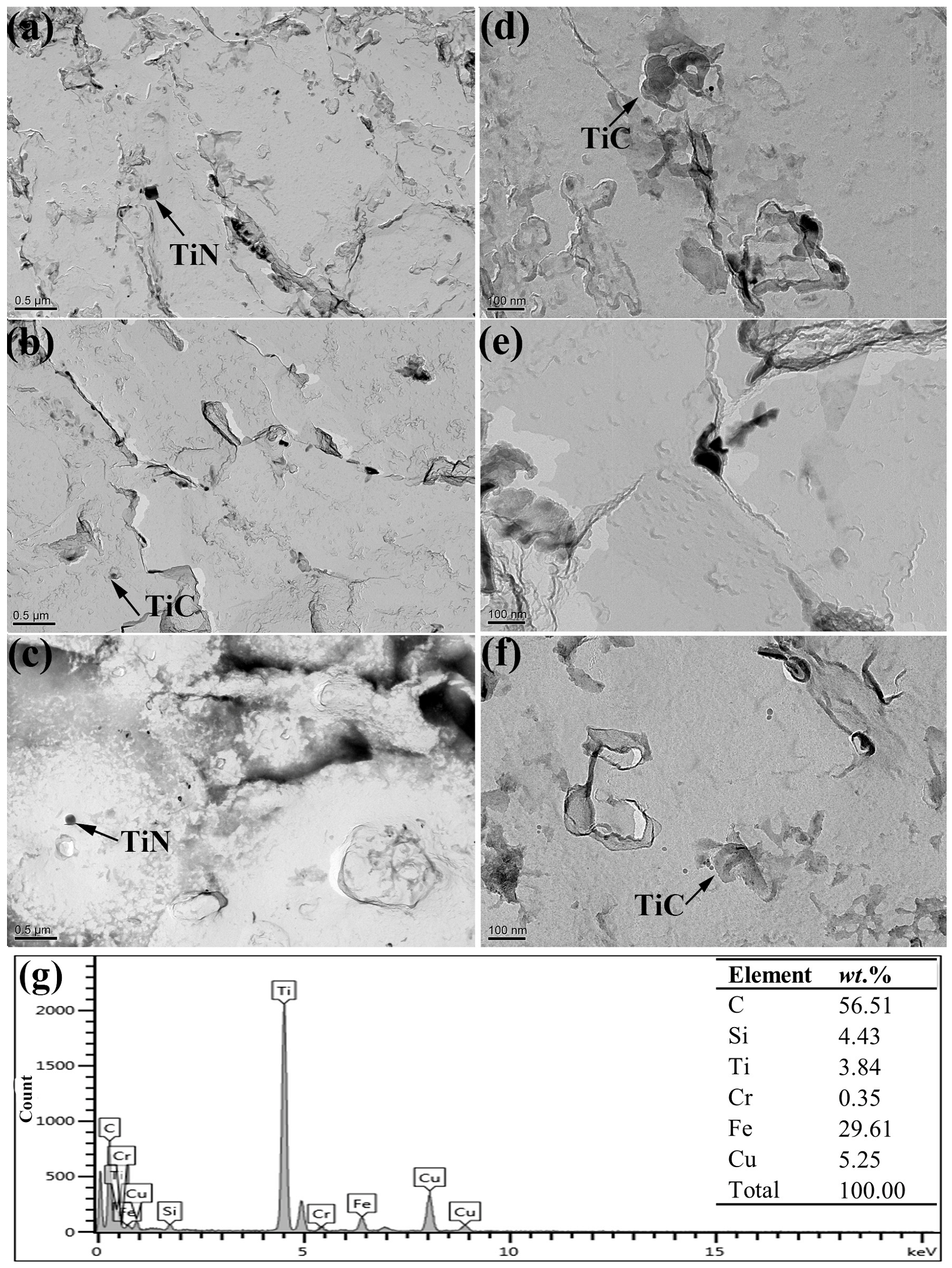

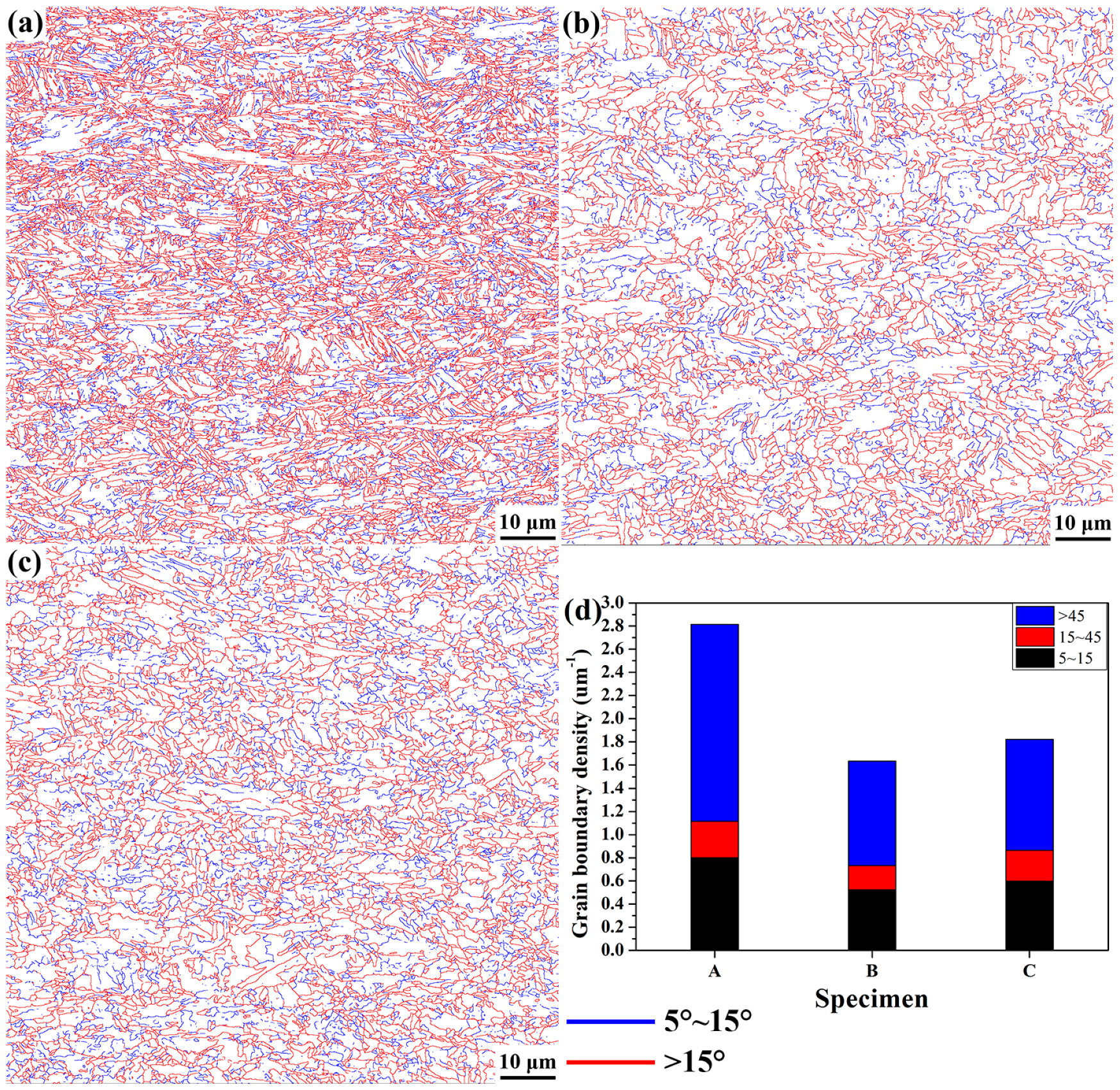

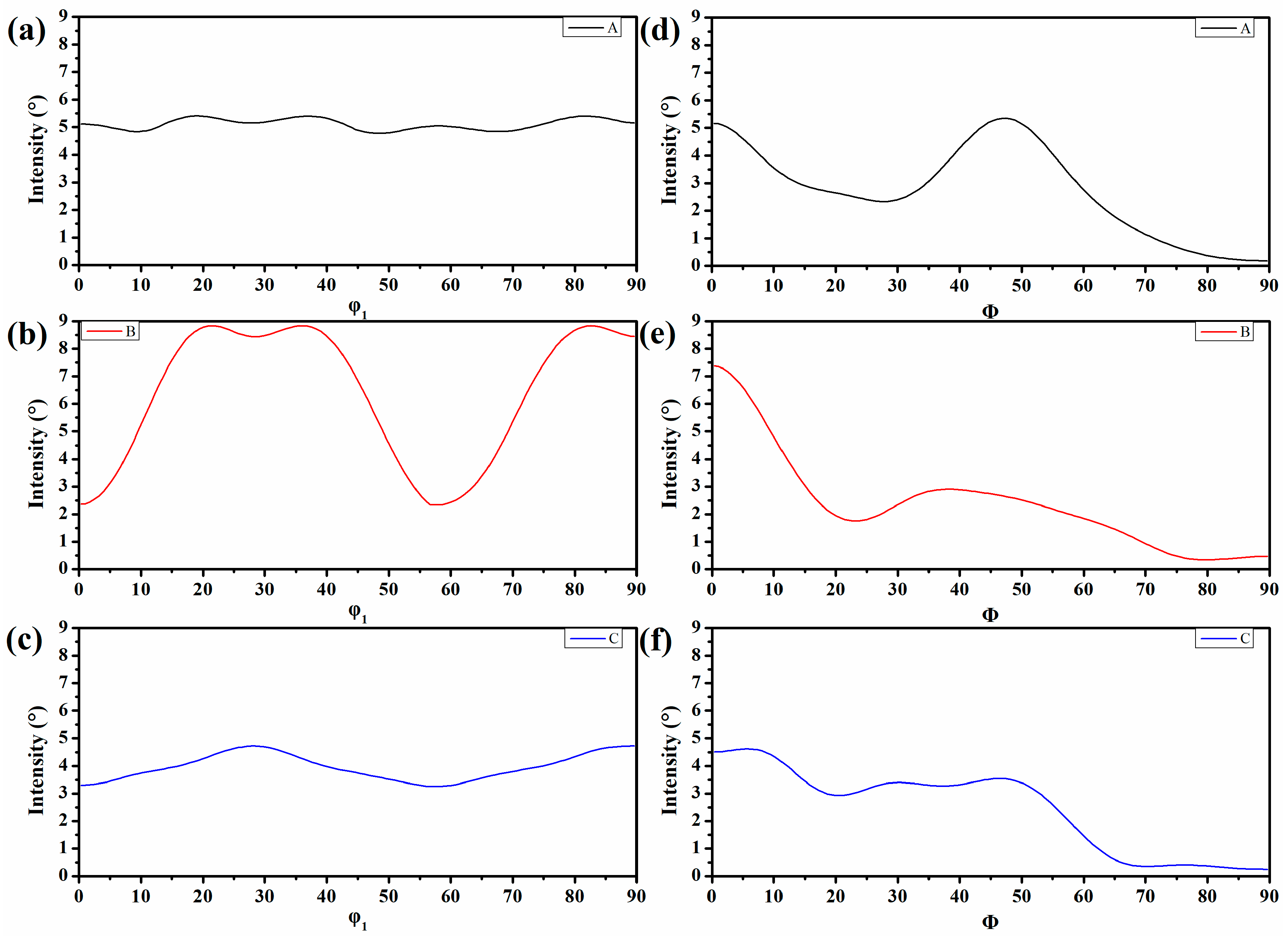
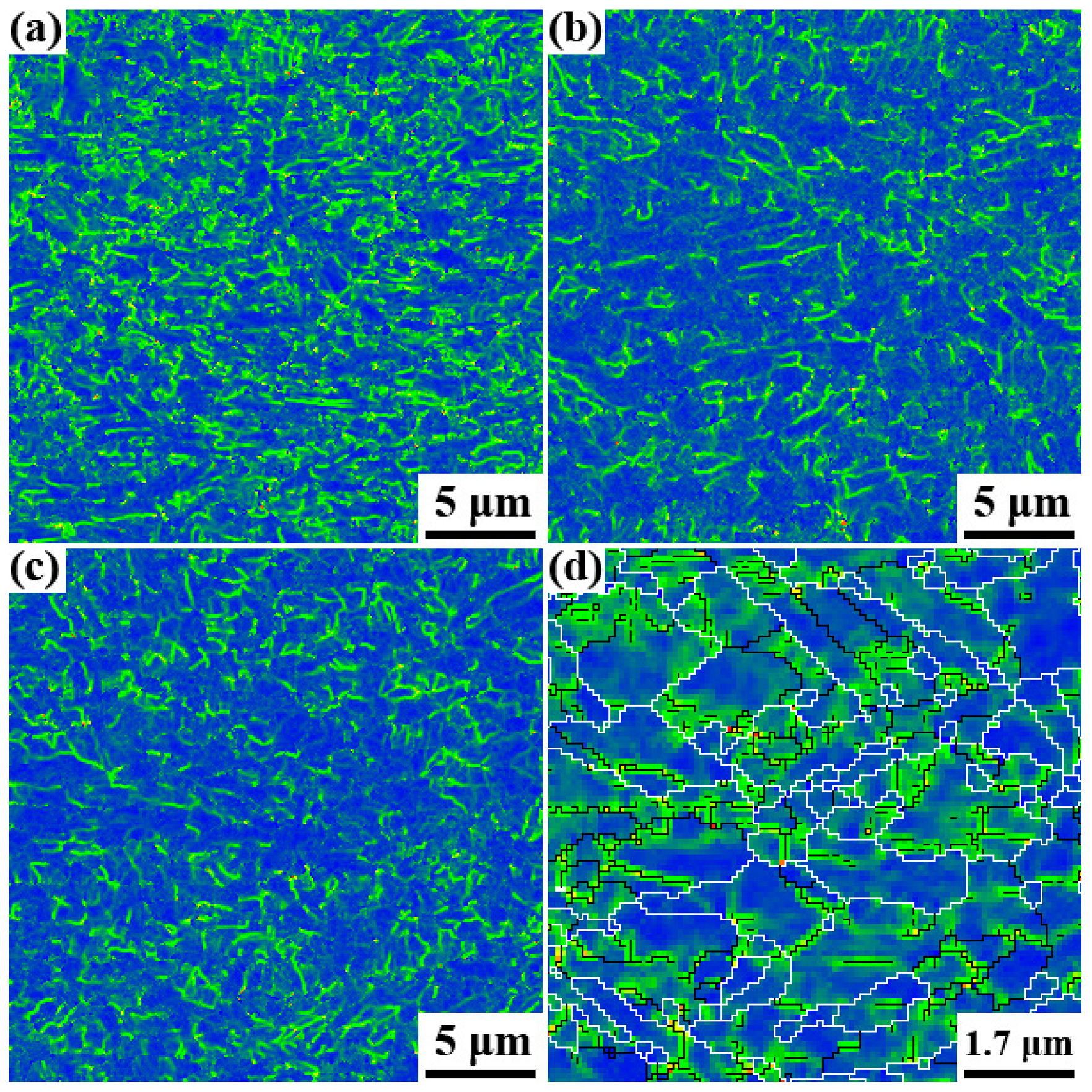
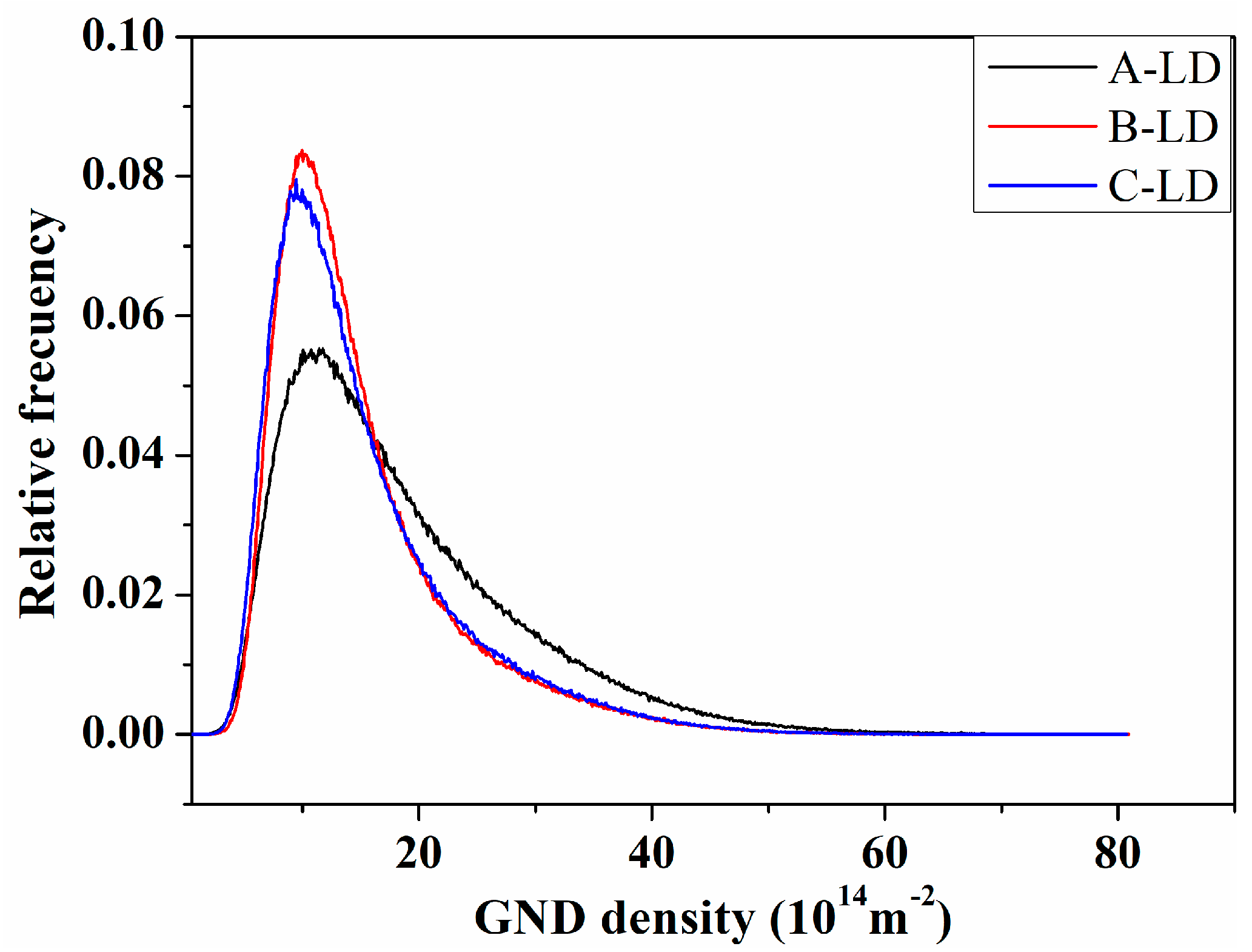
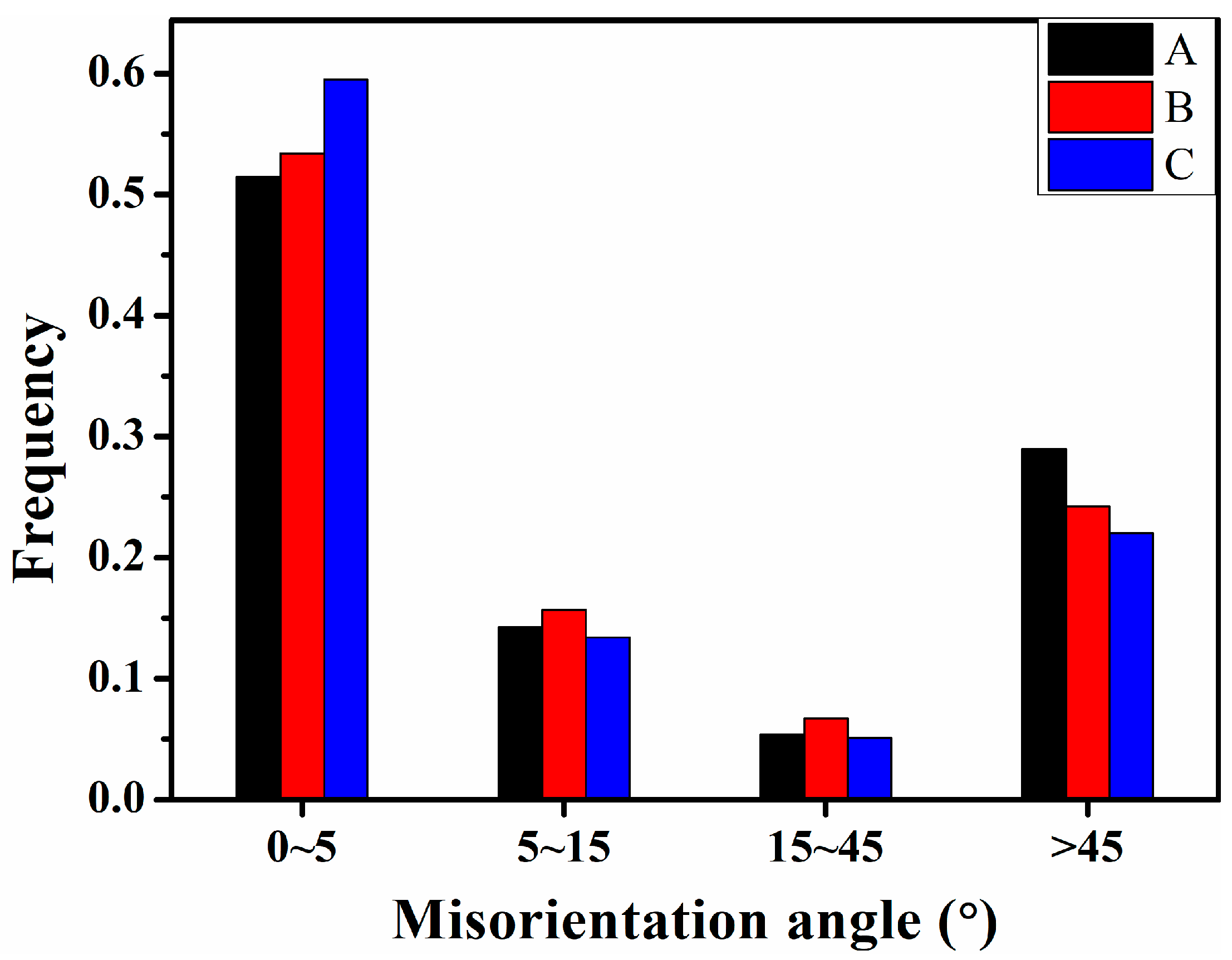





| C | Si | Mn | P | S | Cr | Ti |
|---|---|---|---|---|---|---|
| 0.06 | 0.56 | 1.71 | 0.012 | 0.002 | 0.32 | 0.1 |
| Sample | Yield Strength (MPa) | Tensile Strength (MPa) | Total Elongation (%) |
|---|---|---|---|
| A | 716 | 871 | 14.5 |
| B | 804 | 908 | 12.5 |
| C | 812 | 910 | 9.5 |
| Euler Angle (φ1, Φ, φ2) | ||
|---|---|---|
| Exact K-S OR | 114.2°, 10.5°, 204.2° | |
| Actual OR | A | 120.8°, 9.2°, 195.8° |
| B | 119.6°, 9.1°, 196.9° | |
| C | 121.4°, 9.3°, 195.1° | |
| Variant | Parallel Plane | Parallel Direction | Rotation Angle/axis to V1 | CP Group | Bain Group | Boundary Type | |||
|---|---|---|---|---|---|---|---|---|---|
| Exact K-S OR | Specimen A | Specimen B | Specimen C | ||||||
| V1 | (111)γ//(011)α | [−101]γ//[−1−11]α | - | - | - | - | CP1 | B1 | Block |
| V2 | [−101]γ//[−11−1]α | 60.0°/[11−1] | 60.2°/[0.53, 0.55, −0.64] | 60.2°/[−0.55, −0.53, 0.64] | 60.2°/[0.53, 0.64, −0.55] | B2 | Block | ||
| V3 | [01−1]γ//[−1−11]α | 60.0°/[011] | 60.0°/[−0.03, 0.70, −0.71] | 60.0°/[−0.51, 0.44, −0.72] | 60.0°/[−0.02, 0.70, −0.71] | B3 | block | ||
| V4 | [01−1]γ//[−11−1]α | 10.5°/[0−1−1] | 5.7°/[0.00, −0.61, −0.79] | 5.8°/[0.00, −0.83, −0.56] | 5.7°/[0.00, −0.63, −0.77] | B1 | Sub-Block | ||
| V5 | [1−10]γ//[−1−11]α | 60.0°/[0−1−1] | 60.0°/[0.70, −0.71, 0.03] | 60.0°/[0.47, 0.72, −0.51] | 60.0°/[0.70, 0.71, −0.02] | B2 | Block | ||
| V6 | [1−10]γ//[−11−1]α | 49.5°/[011] | 54.4°/[0.04, 0.71, 0.71] | 54.3°/[−0.04, 0.71, 0.71] | 54.4°/[0.03, 0.71, 0.71] | B3 | Block | ||
| V7 | (1–11)γ//(011)α | [10−1]γ//[−1−11]α | 49.5°/[−1−11] | 51.2°/[−0.52, −0.61, 0.61] | 51.6°/[−0.61, −0.52, 0.61] | 50.8°/[−0.61, −0.52, 0.61] | CP2 | B2 | Packet |
| V8 | [10−1]γ//[−11−1]α | 10.5°/[11−1] | 9.7°/[0.68, 0.68, −0.25] | 9.3°/[0.69, 0.69, −0.24] | 10.0°/[0.68, 0.68, −0.26] | B1 | Packet | ||
| V9 | [−1−10]γ//[−1−11]α | 50.5°/[−103−13] | 52.4°/[−0.65, 0.21, −0.73] | 52.4°/[−0.66, 0.21, −0.72] | 52.3°/[−0.65, 0.21, −0.73] | B3 | Packet | ||
| V10 | [−1−10]γ//[−11−1]α | 50.5°/[−7−55] | 51.2°/[−0.69, −0.45, 0.57] | 51.3°/[−0.69, −0.45, 0.57] | 51.0°/[−0.69, −0.45, 0.56] | B2 | Packet | ||
| V11 | [011]γ//[−1−11]α | 14.9°/[1351] | 13.0°/[0.87, 0.49, 0.06] | 12.9°/[0.88, 0.47, 0.07] | 13.2°/[0.87, 0.50, 0.06] | B1 | Packet | ||
| V12 | [011]γ//[−11−1]α | 57.2°/[−356] | 58.0°/[−0.66, 0.19, −0.73] | 58.0°/[−0.66, 0.18, −0.73] | 57.9°/[−0.66, 0.19, −0.73] | B3 | Packet | ||
| V13 | (–111)γ//(011)α | [0−11]γ//[−1−11]α | 14.9°/[5−13−1] | 13.0°/[0.49, −0.87, −0.06] | 12.9°/[0.47, −0.88, −0.06] | 13.2°/[0.50, −0.87, −0.06] | CP3 | B1 | Packet |
| V14 | [0−11]γ//[−11−1]α | 50.5°/[−55−7] | 51.2°/[−0.57, 0.45, −0.69] | 51.3°/[−0.57, 0.45, −0.69] | 51.0°/[−0.56, 0.45, −0.69] | B3 | Packet | ||
| V15 | [−10−1]γ//[−1−11]α | 57.2°/[−6−25] | 56.6°/[−0.71, −0.24, 0.66] | 57.0°/[−0.71, −0.66, 0.25] | 56.3°/[−0.71, −0.24, 0.66] | B2 | Packet | ||
| V16 | [−10−1]γ//[−11−1]α | 20.6°/[11−11−6] | 16.2°/[0.69, −0.69, −0.23] | 16.3°/[0.69, −0.69, −0.21] | 16.4°/[0.69, −0.69, −0.24] | B1 | Packet | ||
| V17 | [110]γ//[−1−11]α | 51.7°/[−116−11] | 51.4°/[−0.65, 0.39, −0.65] | 52.3°/[−0.66, 0.35, −0.66] | 51.3°/[−0.65, 0.39, −0.65] | B3 | Packet | ||
| V18 | [110]γ//[−11−1]α | 47.1°/[−24−102] | 51.2°/[−0.70, −0.28, 0.65] | 51.3°/[−0.71, −0.28, 0.65] | 50.9°/[−0.70, −0.27, 0.66] | B2 | Packet | ||
| V19 | (11–1)γ//(011)α | [−110]γ//[−1−11]α | 50.5°/[−31310] | 52.4°/[−0.21, 0.73, 0.65] | 52.4°/[−0.21, 0.72, 0.66] | 52.3°/[−0.21, 0.73, 0.65] | CP4 | B3 | Packet |
| V20 | [−110]γ//[−11−1]α | 57.2°/[36−5] | 58.0°/[−0.19, −0.73, −0.66] | 58.0°/[0.19, 0.73, −0.66] | 58.0°/[−0.19, −0.73, −0.66] | B2 | Packet | ||
| V21 | [0−1−1]γ//[−1−11]α | 20.6°/[30−1] | 18.0°/[0.99, 0.00, −0.15] | 17.8°/[0.99, 0.00, −0.14] | 18.4°/[0.99, 0.00, −0.16] | B1 | Packet | ||
| V22 | [0−1−1]γ//[−11−1]α | 47.1°/[−102124] | 51.2°/[−0.28, 0.65, 0.70] | 51.3°/[−0.28, 0.65, 0.71] | 50.9°/[−0.27, 0.66, 0.70] | B3 | Packet | ||
| V23 | [101]γ//[−1−11]α | 57.2°/[−2−5−6] | 56.6°/[−0.24, −0.66, −0.71] | 56.8°/[−0.25, −0.71, −0.66] | 56.3°/[−0.24, −0.66, −0.71] | B2 | Packet | ||
| V24 | [101]γ//[−11−1]α | 21.1°/[9−40] | 18.4°/[0.96, −0.27, 0.00] | 18.3°/[0.96, −0.29, 0.00] | 18.7°/[0.96, −0.26, 0.00] | B1 | Packet | ||
| Variant Pairing to V1 | Misorientation [°] | Max m’ | ||
|---|---|---|---|---|
| {110}[111] | {112}[111] | {123}[111] | ||
| V2 | 60.2 | 1.00 | 1.00 | 1.00 |
| V3 | 60.0 | 0.98 | 0.98 | 0.96 |
| V4 | 5.7 | 0.99 | 0.99 | 1.00 |
| V6 | 54.4 | 0.96 | 0.95 | 0.96 |
| V7 | 51.2 | 0.99 | 0.99 | 0.99 |
| V8 | 9.7 | 0.99 | 0.99 | 0.99 |
| V9 | 52.4 | 0.92 | 0.93 | 0.92 |
| V10 | 51.2 | 0.97 | 0.98 | 0.98 |
| V11 | 13.0 | 0.97 | 0.97 | 0.97 |
| V12 | 58.0 | 0.95 | 0.95 | 0.96 |
| V15 | 56.6 | 0.93 | 0.94 | 0.93 |
| V16 | 16.2 | 0.96 | 0.96 | 0.99 |
| V17 | 51.4 | 0.97 | 0.96 | 0.97 |
| V18 | 51.2 | 0.94 | 0.93 | 0.94 |
| V21 | 18.0 | 0.95 | 0.95 | 0.96 |
| V24 | 18.4 | 0.95 | 0.95 | 0.96 |
Publisher’s Note: MDPI stays neutral with regard to jurisdictional claims in published maps and institutional affiliations. |
© 2021 by the authors. Licensee MDPI, Basel, Switzerland. This article is an open access article distributed under the terms and conditions of the Creative Commons Attribution (CC BY) license (https://creativecommons.org/licenses/by/4.0/).
Share and Cite
Wang, Z.; Guo, Z.; Shang, C.; Chen, B.; Hui, Y. Characterization of the Stretch Flangeabitity of High-Strength Bainitic Steel: The Significance of Variant Pairs. Materials 2022, 15, 276. https://doi.org/10.3390/ma15010276
Wang Z, Guo Z, Shang C, Chen B, Hui Y. Characterization of the Stretch Flangeabitity of High-Strength Bainitic Steel: The Significance of Variant Pairs. Materials. 2022; 15(1):276. https://doi.org/10.3390/ma15010276
Chicago/Turabian StyleWang, Zhiquan, Zifeng Guo, Chengjia Shang, Bin Chen, and Yajun Hui. 2022. "Characterization of the Stretch Flangeabitity of High-Strength Bainitic Steel: The Significance of Variant Pairs" Materials 15, no. 1: 276. https://doi.org/10.3390/ma15010276





